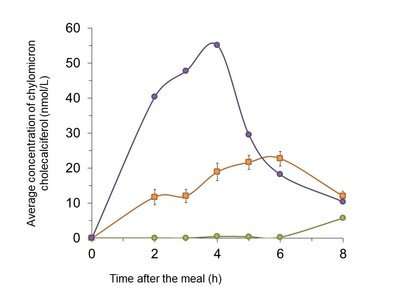The following graph represents the variations in plasma concentration of vitamin D3 among 39 healthy men, over a period of 8 hours after ingesting a test meal containing 5 mg of vitamin D3. Once it has been absorbed, this vitamin is transported via the bloodstream by the chylomicrons (particles formed in the intestine that transport newly-absorbed lipids and lipid-micronutrients to the liver). Credit: INRA-France
Approximately 0.1%: that is the average genetic difference between two individuals. This small percentage is responsible for the variations of certain physical traits, such as eyes, hair, and height, but also for differences in our susceptibility to certain diseases and our capacity to absorb vitamins and phytomicronutrients (carotenoids, polyphenols, etc.), involved in the prevention of chronic disease. Based on the study of genetic interindividual variability, researchers from INRA and Aix-Marseille University have published a review on current knowledge of nutrigenetics in the Annual Review of Nutrition on 21 August 2018. The objective of this emerging science is to personalize nutritional recommendations in order to optimize nutrient, micronutrient, and phytomicronutrient allowances by taking into account genetic differences between individuals and groups of individuals.
Why do vitamin requirements and our capacity to absorb them differ from one individual to another1? Previous studies have shown that the capacity to absorb some vitamins varies considerably between individuals, for example, by a factor of 34 in the case of vitamin D. A better understanding of individual nutritional requirements will allow scientists to make more personalized nutritional recommendations, which is precisely the aim of nutrigenetics. Even though we do not know all the factors responsible for interindividual variability yet, genetics already seems to be one of the most decisive.
Researchers from INRA and Aix-Marseille University have compiled current knowledge about genetic interindividual variability in regard to the absorption of micronutrients, especially fat-soluble vitamins (A, D, and E), carotenoids (plant pigments such as beta-carotene, lycopene, and lutein), and phytosterols (plant-derived sterols). Given the fact that our body cannot produce them and that they are either essential for it to function well (vitamins) or capable of enhancing the beneficial effects of fruits and vegetables (certain phytomicronutrients), human beings must obtain these micronutrients through the diet. Furthermore, an adequate intake of vitamins and phytochemicals like carotenoids or polyphenols is essential to prevent conditions such as cancer and cardiovascular, neurodegenerative and ocular diseases.
Recent information shows that interindividual variability in the bioavailability of certain micronutrients is modulated by single nucleotide polymorphisms (SNPs)2. The identified SNPs are located in genes involved in the intestinal uptake and transport of these compounds. The effect of each SNP is usually low, but a combination of SNPs can explain a significant part of interindividual variability. For example, the researchers discovered that the interindividual variability in the bioavailability of vitamin E is modulated, at least to some extent, by a combination of 28 SNPs in 11 genes.
Research suggests that other types of genetic variations could also be involved in the bioavailability of these micronutrients, for instance, copy number of certain genes associated with micronutrient absorption and metabolism. Factors other than genetic could be involved as well. One example is the microbiota, which has been proven to participate in the regulation and absorption of certain micronutrients.
The scientists continue their research in order to identify the genetic variations involved in the absorption of other nutrients or phytomicronutrients. Two such studies are currently underway, concerning cholesterol and phytoene and phytofluene, two phytomicronutrients present in tomatoes. Their main objective is to define genetic scores that can accurately predict the way in which nutrients, micronutrients and phytomicronutrients are absorbed according to each genotype. In the future, these results should allow us to optimize intake recommendations of compounds involved in the prevention of certain diseases, taking into account the genetic characteristics of each individual.
Interindividual variability and the capacity to absorb vitamin D3
Vitamin D3 (cholecalciferol) is known to be crucial for bone metabolism. However, recent data suggests that its biological role goes well beyond that, since its deficiency increases the risk of developing certain diseases. Paradoxically, research on the absorption of vitamin D is still scarce.
Scientists measured vitamin D3 concentration from the chylomicrons of each individual. The orange curve represents the average values from all 39 men, whereas the purple and the green curves represent the individual with the best and worst results respectively. This variability can be explained, for the most part, by a combination of 17 SNP in 13 genes.
More information: Charles Desmarchelier et al. A Combination of Single-Nucleotide Polymorphisms Is Associated with Interindividual Variability in Cholecalciferol Bioavailability in Healthy Men, The Journal of Nutrition (2016). DOI: 10.3945/jn.116.237115
Journal information: Journal of Nutrition
Provided by INRA-France





















